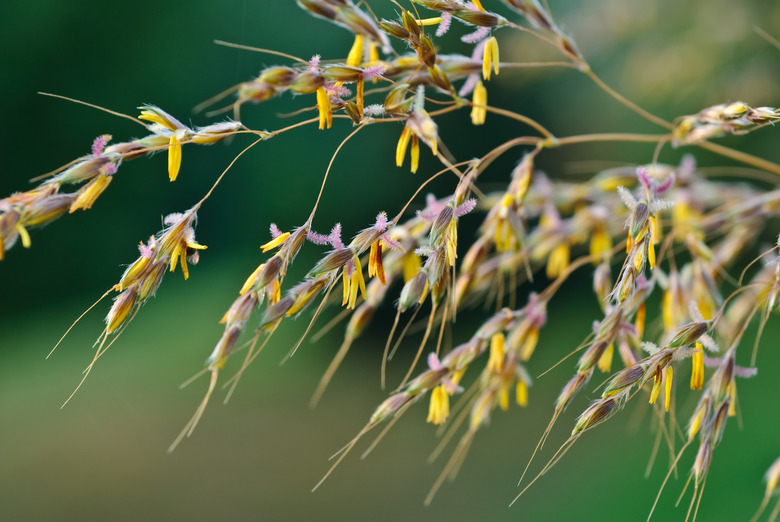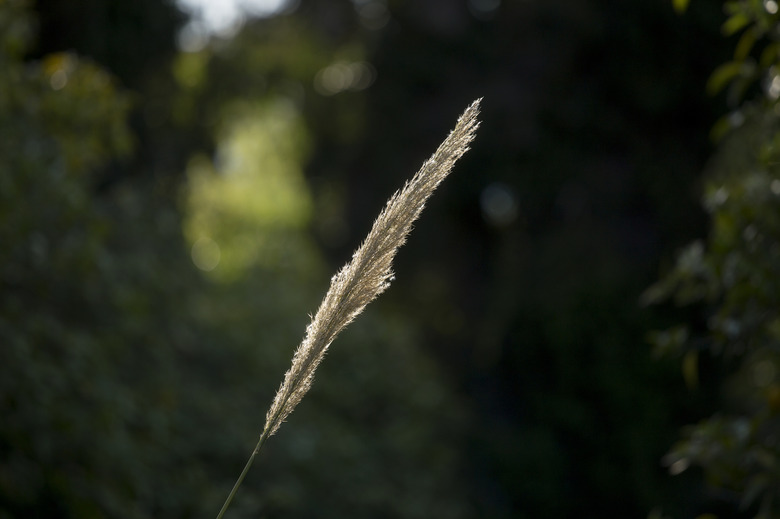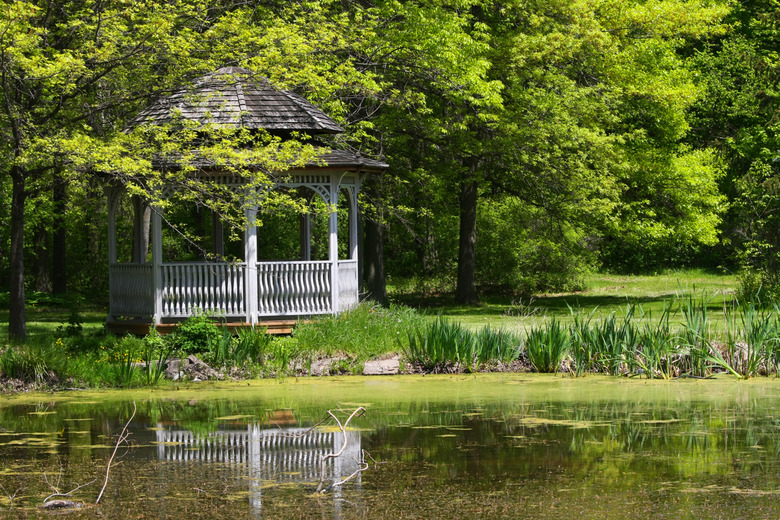Ornamental Grasses That Like Wet Soil
Low-lying wet areas of a garden require special kinds of plants. Many trees, shrubs and other perennials need well-drained soil, but some plants prefer moist to wet or boggy soil. Water-loving ornamental grasses provide a serene landscape with their waving plumes floating above their mounds of grassy foliage.
Sun-Loving Specimens
Each ornamental grass has specific cultural requirements, with sunlight being just as important as soil's moisture level. Prairie cordgrass (Spartina pectinata), which is a native species, and the sugarcane plumegrass cultivar 'Red Mountain' (Erianthus giganteus 'Red Mountain') thrive in full-sun locations with moist to wet soil. A warm-season plant, prairie cordgrass grows up to 5 feet tall plus an additional 2 feet when it flowers in fall. It grows as a perennial, or is hardy, in U.S. Department of Agriculture plant hardiness zones 4 through 9. 'Red Mountain' sugarcane plumegrass is also a warm-season grass. Hardy in USDA zones 6 through 8, it grows 2 to 3 feet tall in mounds and has late-fall flowers, the stalks of which reach 6 to 7 feet tall.
- Low-lying wet areas of a garden require special kinds of plants.
- Prairie cordgrass** (Spartina pectinata), which is a native species, and the sugarcane plumegrass cultivar 'Red Mountain' (Erianthus giganteus 'Red Mountain') thrive in full-sun locations with moist to wet soil.
Other sun-loving varieties that do well in moist to wet soil include:
- Blue love grass (Eragrostis chloromelas, USDA zones 7 through 9), with foliage growing 3 feet tall and flower stalks up to 4 feet tall.
- Bushy bluestem (Andropogon glomeratus, USDA zones 5 through 9), growing foliage up to 4 feet tall and flower stalks 6 feet tall.
- Grassy-leaved sweet flag cultivar 'Ogon' (Acorus gramineus 'Ogon,' USDA zones 5 through 9), which grows 6 to 12 inches tall and has inconspicuous flowers.
- Indian grass (Sorghastrum nutans, USDA zones 2 through 9), with foliage 3 to 4 feet in height and flower stalks 5 to 8 feet tall.
- 'Northern Lights' tufted hair grass (Deschampsia caespitosa 'Northern Lights,' USDA zones 4 though 9), which grows up to 1 foot tall and does not flower.
Partial-Shade Varieties
Some ornamental grasses that thrive in wet or moist soil thrive in partial or dappled shade, making them suitable for gardens under tree canopies or other areas shaded from afternoon sun. An example is the cool-season grass Canada bluejoint (Calamagrostis canadensis, USDA zones 3 through 8). Its foliage grows 2 feet tall, and flowering plumes add another 2 feet of height to this North American native. Variegated river oats (Chasmanthium latifolium 'River Mist,' USDA zones 5 through 9), another example, adds color to a partial-shade or shade garden with its 2 1/2-foot-tall, green-and-white-striped blades. It is a warm-season grass.
- Other sun-loving varieties that do well in moist to wet soil include: * Blue love grass (Eragrostis chloromelas, USDA zones 7 through 9), with foliage growing 3 feet tall and flower stalks up to 4 feet tall.
* Bushy bluestem (Andropogon glomeratus, USDA zones 5 through 9), growing foliage up to 4 feet tall and flower stalks 6 feet tall. - * 'Northern Lights' tufted hair grass (Deschampsia caespitosa 'Northern Lights,' USDA zones 4 though 9), which grows up to 1 foot tall and does not flower.
Some ornamental grasses that thrive in wet or moist soil thrive in partial or dappled shade, making them suitable for gardens under tree canopies or other areas shaded from afternoon sun.
Other ornamental grasses and grasslike perennials that thrive in moist to wet, partial-shade sites include:
- 'Evergold' variegated Japanese sedge (Carex oshimensis 'Evergold,' USDA zones 5 through 9), growing 6 to 8 inches tall with small flowers.
- Fox sedge (Carex vulpinoidea, USDA zones 3 through 7), which grows 1 to 3 feet tall.
- Gray's sedge (Carex grayi, USDA zones 3 through 9), with foliage growing 2 feet tall and flowers reaching up to 3 feet tall.
Shade-Loving Selections
Many of the shade-loving ornamental grasses thrive in woodlands along creeks and rivers, where the soil is consistently moist and rich with organic matter. Virginia wild rye (Elymus virginicus, hardy in USDA zones 3 through 9) is one of them. Its foliage grows up to 3 feet tall; when it blooms in spring, the plumes rise to 4 feet tall. It tolerates soil conditions ranging from moist to wet with occasional dry spells. Hakone grass (Hakonechloa macra, USDA zones 4 through 7) also thrives in shade. It is a warm-season grass that grows 1 1/2 to 2 feet tall. Additional ornamental grasses for shady moist to wet locations include:
- Other ornamental grasses and grasslike perennials that thrive in moist to wet, partial-shade sites include:
* 'Evergold' variegated Japanese sedge (Carex oshimensis 'Evergold,' USDA zones 5 through 9), growing 6 to 8 inches tall with small flowers.
- Bronze veil tufted hair grass (_Deschampsia cespitosa_ 'Bronzeschleier,' USDA zones 4 through 9), with 1-foot-tall foliage and flower plumes up to 3 feet tall.
- Golden variegated hakone grass (Hakonechloa macra 'Aureola,' USDA zones 4 through 7), which grows 1 1/2 to 2 feet tall.
Types Of Ornamental Grasses
Ruby Grass (Melinus nerviglumis or Rhynchelytrum nerviglume) is a full-sun plant that packs a powerful punch despite its compact 1-by-1-foot size. This bunch grass reaches 3 feet high and wide, bearing feather-like spring flowers against stiff needle-like lime-green foliage. The rosy-colored Pink Muhly Grass (Muhlenbergia capillaris) spreads to 3 feet high and 4 feet wide in USDA plant hardiness zones 6 to 9. Giant Feather grass (Stipa gigantean) is a clumping evergreen plant that grows 2 feet high and 4 feet wide with blooms that extend 3 to 4 feet above the foliage. It forms a dense mound of fine-textured gray-green rolled leaves with golden spring blooms. According to Pamela M. Geisel of the California Statewide Master Gardener program, two grasses to avoid because they are considered invasive are Mexican Feather Grass (Nassella tenuissima) and Chilean Needle grass (Nassella neesiana).
- * Bronze veil tufted hair grass (_Deschampsia cespitosa_ 'Bronzeschleier,' USDA zones 4 through 9), with 1-foot-tall foliage and flower plumes up to 3 feet tall.
* Golden variegated hakone grass (Hakonechloa macra 'Aureola,' USDA zones 4 through 7), which grows 1 1/2 to 2 feet tall. - Ruby Grass (Melinus nerviglumis or Rhynchelytrum nerviglume) is a full-sun plant that packs a powerful punch despite its compact 1-by-1-foot size.
Warning
Ornamental grasses tend to be invasive. Use caution when planting rapidly growing species with prolific flowers and seed heads. Wind, birds and other wildlife carry seeds to locations outside a garden or yard, where they may sprout and invade wetlands and other areas, crowding out native plants. Help prevent the spread of ornamental grasses by deadheading their flower plumes before they develop seeds.
References
- Hoffman Nursery: Ornamental Grasses
- Monrovia: 'Northern Lights' Tufted Hair Grass
- Perennials.com: Carex Oshimensis 'Evergold'
- Clemson Cooperative Extension: Plants for Damp or Wet Areas
- Missouri Botanical Garden: Chasmanthium Latifolium
- Hoffman Nursery: Carex Grayi
- Clemson Cooperative Extension: Liriope
- University of California Marin Master Gardeners: Plant Guide: Ruby Grass
- University of California Marin Master Gardeners: Plant Guide: Berkeley Sedge
- University of California Marin Master Gardeners: Plant Guide: New Zealand Wind Grass
- University of California Marin Master Gardeners: Plant Guide: Snow Tussock
- University of California Marin Master Gardeners: Plant Guide: Peruvian Feather Grass
- University of California Marin Master Gardeners: Plant Guide: Cape Rush
- University of California Marin Master Gardeners: Plant Guide: Pink Muhly Grass
- University of California Marin Master Gardeners: Plant Guide: Giant Feather Grass
- University of California Master Gardener Program; "Two Ornamental Grasses Invasive!"; Pamela M. Geisel


